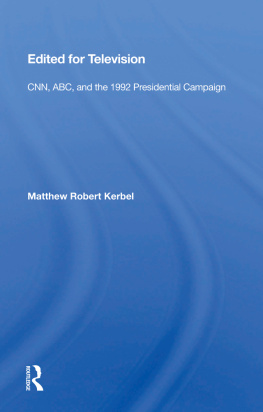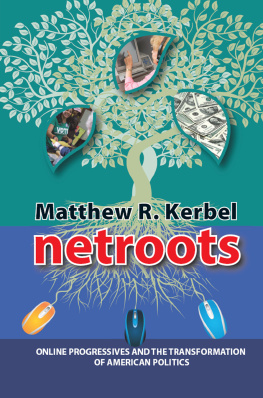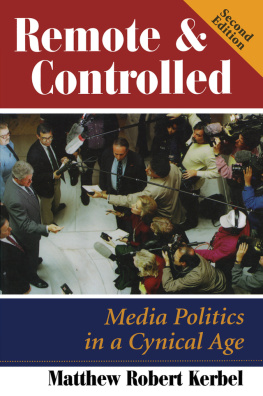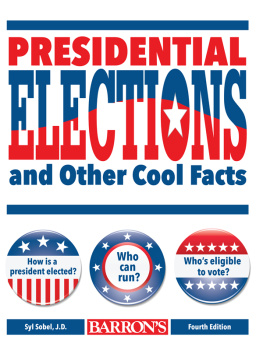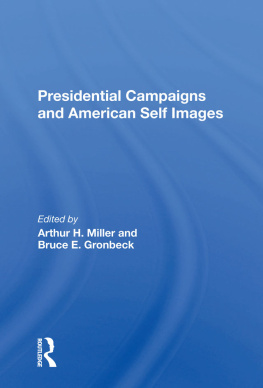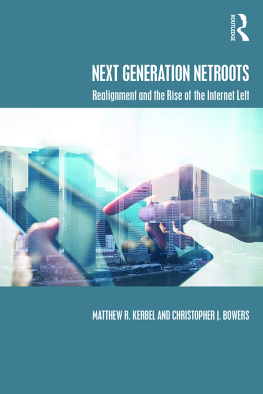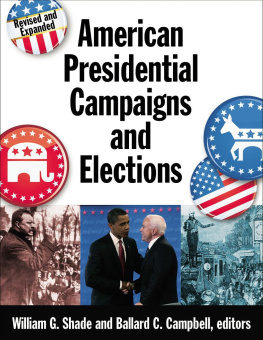First published 1994 by Westview Press
Published 2018 by Routledge
52 Vanderbilt Avenue, New York, NY 10017
2 Park Square, Milton Park, Abingdon, Oxon OX14 4RN
Routledge is an imprint of the Taylor & Francis Group, an informa business
Copyright 1994 by Taylor & Francis
All rights reserved. No part of this book may be reprinted or reproduced or utilised in any form or by any electronic, mechanical, or other means, now known or hereafter invented, including photocopying and recording, or in any information storage or retrieval system, without permission in writing from the publishers.
Notice:
Product or corporate names may be trademarks or registered trademarks, and are used only for identification and explanation without intent to infringe.
Library of Congress Cataloging-in-Publication Data
Kerbel, Matthew Robert, 1958
Edited for television: CNN, ABC, and the 1992 presidential
campaign / Matthew Robert Kerbel.
p. cm.
Includes bibliographical references and index.
ISBN 0-8133-1699-5 (hc.)ISBN 0-8133-1700-2 (pb)
1. PresidentsUnited StatesElection1992. 2. Television
broadcasting of newsUnited States. 3. Television in politics
United States. I. Title.
E884.K46 1994
324.973'0928dc20 93-45690
CIP
ISBN 13: 978-0-367-00768-3 (hbk)
I am a student of the mass media and a former television news writer. I have been on camera on occasion in a professional capacity as one of so many "talking heads," and like everyone in my generation I have watched television all my life. But not until January 21, 1993, while in the midst of writing this book about television election coverage, had I ever been in the center ring of the media circus. That "opportunity" came when my wife's postcard was selected by chance from among 90,000 citizen requests, each submitted to the National Park Service in the hope of beating long odds to be among 2,000 people invited to a White House "open house" on President Clinton's first day in office. Until that day, I had stood behind the cameras as news practitioner and astride them as observer; I was about to find out how it felt to stand in front of them.
What I experienced was an event that seemed more likely to have been arranged by NBC than by the National Park Service. Network and local television cameras panned the line of ticket holders awaiting entry to the White House grounds. Waves of reporters and crews bearing minicams sought pictures and sound bites they believed would interest the home audience: How did you get invited? (answer: "We were lucky"); What will you tell the new president? (answer: "Congratulations"). Once inside, a different array of cameras followed our steps along the South Lawn. As we approached the West Wing, the procession of visitors ground to a halt at a table where everyone was assigned a numbernot for security purposes, but because the cable network C-SPAN wanted a record of presidential visitors.
As we were each in turn introduced to President Clinton and Vice President Gore, our words were captured by microphone and our images recorded on videotape. Reporters and their paraphernalia occupied a space as prominent as that of America's new leaders, crowding four rows deep behind the backs of the guests. Even as the visit ended, the press encounter lingered. At the foot of the White House driveway, reporters held signs bearing the names of their home cities and states, trying to connect with hometown residents for interviews with a local flavor (to obtain locai answers to questions like, "How did you get invited?" and "What did you tell the new president?").
I see the impact of the media on this open house as a personal metaphor for one of the central themes of this book: The impact of television is such that it has grown beyond simply covering the story, beyond even shaping the story, to the point where it often is the story. Just as the trip to the White House to meet the president became a trip to the White House to meet the press, news coverageor at least television election coveragequite often offers no more than a story about the reporters themselves: what they endure, how they feel, the way they do their jobs. It is a story of great interest to those who write it but of questionable utility, even potentially harmful, to those who consume it. Harmful because at a time when political parties have declined beyond recognition, television finds itself brokering the relationship between candidate and voter to an unprecedented extent. But television is not designed to function like a political party; it has neither the ability nor the desire to aggregate interests and facilitate a candidate-voter dialogue. Responsive to its need to hold and entertain an audience, television pays untold attention to what it finds most engaging and interesting. When this amounts to little more than television's own role in the process, the result is a cynical incantation of what it takes for candidates to win high office in the mass media age.
These observations come from the study that forms the basis for this book: a year-long examination of the content of regularly scheduled evening news broadcasts about the presidential election as they appeared on broadcast (ABC) and cable (CNN) television, supplemented by 44 interviews with members of each network's election news unit. The methodology employed in conducting the content analysis and the interviews is discussed in the . At one level, I investigate what the election looked like on the two networks: its thematic content, its analytical nature, the portrayal of individuals, institutions, and their relationships. At another level, I compare traditional broadcast coverage with its cable counterpart, which only recently has emerged as a respected and powerful media force. At yet another level, I draw conclusions about the nature of the mediated message itself: Using the election as a case study, I examine how television covers events and assess the mixture of organizational, procedural, and personal factors that help to explain why television coverage looks the way it does.
* * *
Like media coverage itself, this book was of course shaped by many influences. I would particularly like to acknowledge the kind assistance of those who helped me at various stages in the life of this project. The book assumes the form it does in part because of the helpful comments of Pamela Shoemaker, Michael Traugott, Kim Kahn, and my colleagues at Villanova, Len Shyles and David Barrett, all of whom took the time to comment on my initial proposal. Dan Amundson assisted me in the development of the coding scheme, and numerous people gave me insight and support as I considered who to interview and what to ask. I am particularly grateful to Norman Ornstein and Larry Sabato for sharing their insights about the television news community, to Bill Porter for helping to guide my initial contacts at the two networks, and to Brooks Jackson and Gene Randall at CNN for their early support of this project.
Several people offered valuable insights at various stages of manuscript development. I would particularly like to thank Ann Crigler, Timothy Cook, Marion Just, Tom Patterson, Robert Spitzer, Holli Sometko, and Michael G. Hagen for their help and guidance; I hope I have done justice to their many fine suggestions. At the two networks, interviews were facilitated and expedited by executive-level support and encouragement, particularly from Hal Bruno at ABC and Tom Johnson and Tom Hannon at CNN. My wonderful research assistants, Sara Robins and David Howell, contributed hours of their time to learn the complex content analysis coding scheme used here and without complaint carried a good deal of the burden for delivering the data effectively and in rapid order. If they never again have the stomach to watch network news, it is a consequence of the invaluable contribution they made to this book.


